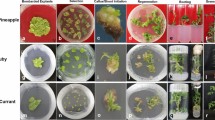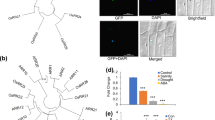Abstract
The petunia nuclear gene which encodes the chloroplast isozyme of superoxide dismutase, SOD-1, has been fused with an efficient rbcS promoter fragment and 3′ flanking region and introduced into tobacco and tomato cells. Transformed plants carrying this chimeric gene have up to 50-fold the levels of SOD-1 which occur in wild-type plants. However, tobacco plants with 30-to 50-fold the normal SOD-1 activity do not exhibit resistance to the light-activated herbicide paraquat. Similarly, tomato plants with 2-to 4-fold increases in SOD-1 do not exhibit tolerance to photoinhibitory conditions known to increase superoxide levels (high light, low temperatures and low CO2 concentrations). Our data indicate that increasing the chloroplastic SOD level in a plant cell is not sufficient to reduce the toxicity of superoxide.
Similar content being viewed by others
References
Arnon DI: Copper enymes in isolated chloroplasts. Polyphenoloxidase in Beta vulgaris. Plant Physiol 24: 1–15 (1949).
Badger M, Andrews TJ, Canvin DT, Lorimer GH: Interactions of hydrogen peroxide with ribulose bisphosphate carboxylase oxygenase. J Biol Chem 255: 7870–7875 (1980).
Bartlett SG, Grossman AR, Chua N-H: In vitro synthesis and uptake of cytoplasmically-synthesized chloroplast proteins In: Edelman M et al. (eds) Methods in Chloroplast Molecular Biology, pp. 1081–1091. Elsevier, Amsterdam (1982).
Baum JA, Scandalios JG: Developmental expression and intracellular localization superoxide dismutases in maize. Differentiation 13: 133–140 (1979).
Baum JA, Chandlee JM, Scandalios JG: Purification and partial characterization of a genetically-defined superoxide dismutase (SOD-1) associated with maize chloroplasts. Plant Physiol: 73: 31–35 (1983).
Bjorkman O: Low-temperature chlorophyll fluorescence in leaves and its relationship to photon yield of photosynthesis in photoinhibition. In: Kyle DJ, Osmond CB, Arntzen CJ (eds) Photoinhibition, pp. 123–144. Elsevier Science Publishers (Biomedical Division), Amsterdam/New York/Oxford.
Bowler C, Alliotte T, DeLoose M, VanMontagu M, Inze D: The induction of manganese superoxide dismutase in response to stress in Nicotiana plumbaginifolia. EMBO J 8: 31–38 (1989).
Bradford MM: A rapid and sensitive method for the quantitation of microgram quantities of protein utilizing the principle of protein-dye binding. Anal Biochem 72: 248–254 (1976).
Cannon RE, White JA, Scandalio JG: Cloning of cDNA for maize superoxide dismutase 2 (SOD2). Proc Natl Acad Sci USA 84: 170–183 (1987).
Dean C, van denElzen P, Tamaki S, Dunsmuir P, Bedbrook J: Differential expression of the eight genes of the petunia ribulose bisphosphate carboxylase small subunit multi-gene family. EMBO J 4: 3055–3061 (1985).
Dean C, Favreau M, Dunsmuir P, Bedbrook J: Confirmation of the relative expression levels of the Petunia (Mitchell) rbcS genes. Nucl Acids Res 15: 4655–4668 (1987).
Dean C, Favreau M, Tamaki S, Jones J, Dunsmuir P, Bedbrook J: Expression of Petunia rbcS gene fusions in transformed tobacco plants. In: Key J, McIntosh L (eds) Plant Gene Systems and their Biology, pp. 289–295 (1987)
Dean C, Favreau M, Tamaki S, Bond-Nutter D, Dunsmuir P, Bedbrook J: Expression of tandem gene fusions in transgenic tobacco plants. Nucl Acids Res 16: 9267–9283 (1988).
Elstner EF: Oxygen activation and oxygen toxicity. Ann Rev Plant Physiol 33: 73–96 (1982).
Figurski D, Helinski DR: Replication of an origincontaining derivative of plasmid RK2 dependent on a plasmid function provided in trans. Proc Natl Acad Sci USA 76: 1648–1652 (1979).
Foster JG, Edwards GE: Localization of superoxide dismutase in leaves of C3 and C4 plants. Plant & Cell Physiol 21: 895–906 (1980).
Foyer CH, Halliwell B: The presence of glutathione and glutathione reductase in chloroplasts. A proposed role in ascorbic acid metabolism. Planta 133: 21–25 (1976).
Fridovich I: The biology of oxygen radicals. Science 201: 875–880 (1978).
Gamon JA, Pearcy RW: Leaf movement stress avoidance and photosynthesis in Vitis californica. Oecologia 79: 475–481 (1989).
Halliwell B: The toxic effect of oxygen on plant tissues. In: Oberley LW et al., Superoxide Dismutase, vol. I pp. 89–123 CRC Boca Raton, FL (1982).
Hoekema A, Hirsch PR, Hooykaas PJJ, Schilperoort RA: A binary plant vector strategy based on separation of vir-and T-region of the Agrobacterium tumefaciens Ti-plasmid. Nature 303: 179–180 (1983).
Horsch RB, Fry JE, Hoffman NL, Wallroth M, Eichkoltz D, Rogers SG, Fraley RT: A simple and general method for transferring genes into plants. Science 227: 1229–1231 (1985).
Jones J, Dean C, Gidoni D, Gilbert D, Bond-Nutter D, Lee R, Bedbrook J, Dunsmuir P: High level expression of a bacterial chitinase protein in leaves of transgenic tobacco plants. Mol Gen Genet 212: 536–542 (1988).
Kitagawa Y, Tsunasawa S, Tanaka N, Katsube Y, Sakiyama F, Asada K: Amino acid sequence of copper, Zinc-superoxide dismutase from spinach leaves. J Biochem 99: 1289–1298 (1986).
Kunkel TA: Rapid and efficient site-specific mutagenesis without phenotypic selection. Proc Natl Acad Sci USA 82: 488–492 (1985).
Lee EH, Bennett JH: Superoxide Dismutase. A possible protective enzyme against ozone injury in snap beans (Phaseolus vulgaris L.) Plant Physiol 69: 1444–1449 (1982).
Maniatis T, Fritsch EF, Sambrook J: Molecular Cloning: A Laboratory Manual Cold Spring Harbor Laboratory, Cold Spring Harbor, NY (1982).
Moll BA: Flash-induced fluorescence estimation of Photosystem II electron-transport rates in light-adapted leaves. Biochim Biophys Acta 890: 205–214 (1987).
Perl-Treves R, Nacmias B, Aviv D, Zeelon EP, Galun E: Isolation of two cDNA clones from tomato containing two different superoxide dismutase sequences. Plant Mol Biol 11: 609–623 (1988).
Powles SB, Berry JA, Bjorkman O: Interaction between light and chilling temperature on the inhibition of photosynthesis in chilling-sensitive plants. Plant Cell Envir 6: 117–123 (1983).
Rabinowitch HD, Fridovich I: Superoxide radicals, superoxide dismutase and oxygen toxicity in plants. Rev Photochem Photobiol 37: 679–690 (1983).
Rabinowitch HD, Sklan D: Superoxide dismutase; a possible protective agent against sunscald in tomatoes (Lycopersicon esculentum Mill.) Planta 148: 162–167 (1980).
Scandalios G: Multiple genes controlling superoxide dismutase expression in maize. J Hered 73: 95–100 (1982).
Scioli JR, Zilinskas BA: Cloning and characterization of a cDNA encoding the chloroplastic copper/zinc-super-oxide dismutase from pea. Proc Natl Acad Sci USA 85: 7661–7665 (1988).
Shaaltiel Y, Chua N-H, Gepstein S, Gressel J: Dominant pleiotropy controls enzymes co-segregating with paraquat resistance in Conyza bonariensis. Theor Appl Genet 75: 850–856 (1988).
Shaaltiel Y, Gressel J: Multienzyme oxygen radical detoxifying system correlated with paraquat resistance in Conyza bonariensis. Pesticide Biochem and Physiol 26: 22–28 (1986).
Tanaka K, Sugahara K: Role of superoxide in defense against SO2 toxicity and an increase in superoxide dismutase activity with SO2 fumigation. Plant & Cell Physiol 21: 601–611 (1980).
Taylor JL, Jones JDG, Sandler S, Mueller GM, Bedbrook J, Dunsmuir P: Optimizing the expression of chimeric genes in plant cells. Mol Gen Genet 210: 572–577 (1987).
Tepperman J, Katayama C, Dunsmuir P: Cloning and nucleotide sequence of a petunia gene encoding a chloroplast localized superoxide dismutase. Plant Mol Biol 11: 871–872 (1988).
Vallejos E: Enzyme activity staining. In: Isozymes in Plant Genetics and Breeding, Part 1, pp. 469–516. Elsevier, Amsterdam (1983).
Wise RR, Naylor AW: Chilling-enhanced photo-oxidation. Plant Physiol 83: 272–277 (1977).
Youngman RJ, Dodge AD: On the mechanism of paraquat resistance in Conyza sp. In: Akoyunoglou G (ed) Photosynthesis, V1. Photosynthesis and Productivity Photosynthesis and Environment, pp. 537–543. Balaban International Services, Philadelphia, PA (1981).
Author information
Authors and Affiliations
Rights and permissions
About this article
Cite this article
Tepperman, J.M., Dunsmuir, P. Transformed plants with elevated levels of chloroplastic SOD are not more resistant to superoxide toxicity. Plant Mol Biol 14, 501–511 (1990). https://doi.org/10.1007/BF00027496
Received:
Accepted:
Issue Date:
DOI: https://doi.org/10.1007/BF00027496




